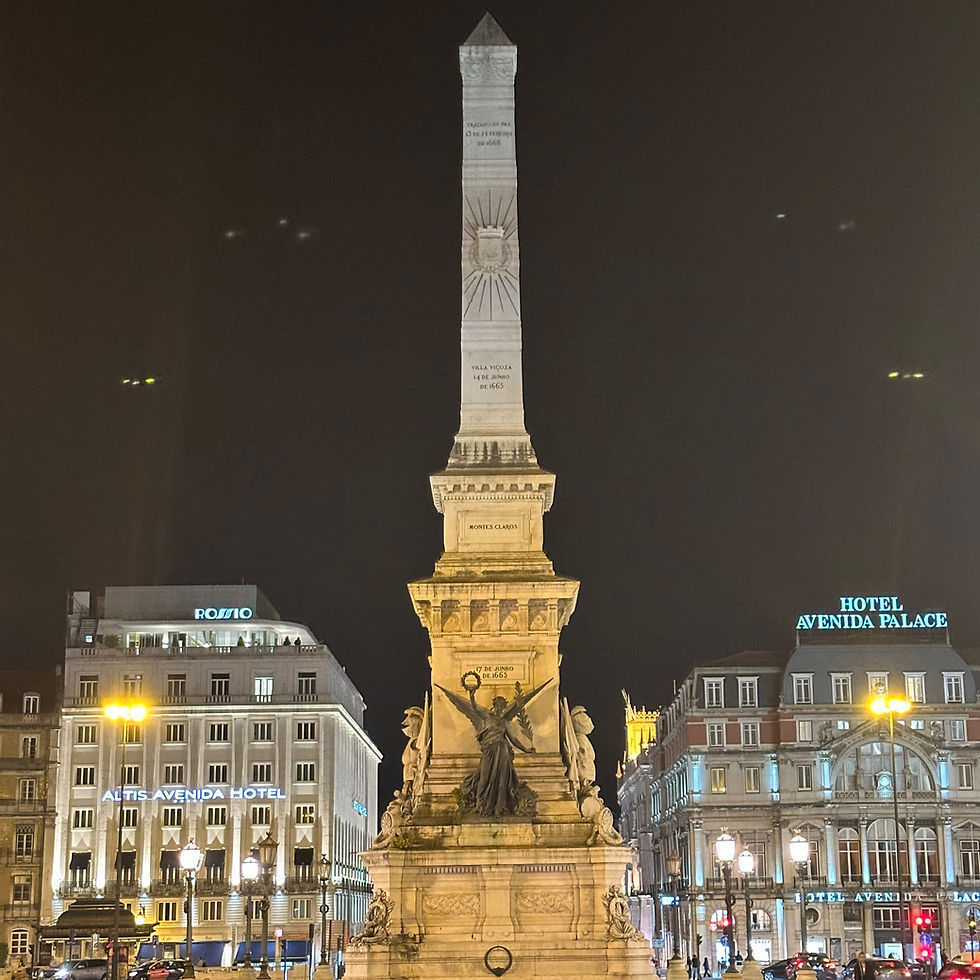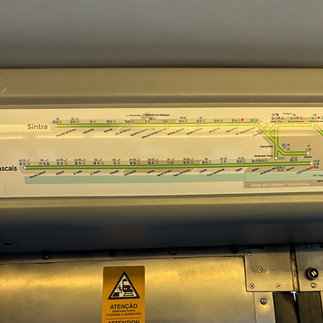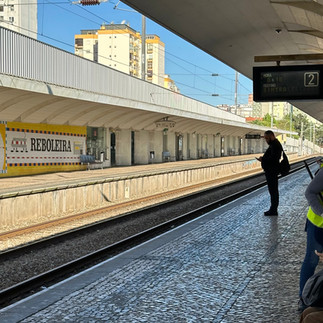Lisbon! A Magical Day in Sintra
- Charles Jordan
- Jul 7
- 13 min read
Updated: Aug 4

In This Article
Getting to Sintra from Lisbon How we started our morning with pastries and made our way to Sintra using the metro and train.
Wandering through Quinta da Regaleira Exploring mossy paths, mysterious wells, and hidden symbols at one of Sintra’s most fascinating estates.
Lunch in the Village A scenic walk into town, a tuna sandwich worth waiting for, and a cold beer to round it out.
Inside the Sintra National Palace Painted ceilings, tiled rooms, and quiet corners in a palace that surprised us with its charm.
Pena Palace: Crowds, Color, and a Standout Chapel Getting there took longer than expected, but the colors, views, and that chapel made it worth it.
What We Skipped (and Why It Was Okay) We missed the Moorish Castle, but ended up with a much-needed break and a pretty great view instead.
Back in Lisbon for the Evening A simple dinner, a stroll down Avenida da Liberdade, and a nightcap to end the day.
A Bit of History in the Praça dos Restauradores What we learned about the monument in the middle of the square — and the war it commemorates.
Starting our Day Bright and Early
We started our day early in Lisbon, seated around 7:30 a.m. at Padaria do Bairro (Neighborhood Bakery) with a warm galão (similar to a cappuccino) and a flaky palmier (elephant ear pastry) to fuel the adventure ahead. With caffeine and sugar in our veins, we walked to the São Sebastião metro station and hopped on the Linha Azul (Blue Line) AKA the Linha da Gaviota (Seagull Line), transferring easily at Reboleira to catch the Comboios de Portugal (CP) train to Sintra.
For our article about the Lisbon Metro, click here.
Taking the Train to Sintra
The signage was excellent in the station and on the trains. At Reboleira we followed the directions to platform 2 for Sintra (could be different, so look at the marquis and head to the Sintra platorm). Traveling with our Lisboa Card made everything seamless. Within about an hour, we were stepping off the train and onto the platform in Sintra. For us it was a total of 10 stops and Sintra is the end of the line. So, there's not a tremendous need to be vigilant IF you're traveling from the Reboleira station. However, depending on where you're coming from in the city, you may have to switch lines at some point during the journey. There are different types of schematic above the interior side of the train doors. They're very helpful for navigation.
Arrival Confusion, Quinta da Regaleira, and a Winding Descent
Our plan was to kick things off at Quinta da Regaleira, and we’d bought timed tickets for 10:00 a.m. What we hadn’t planned was initially boarding the wrong bus, Bus 434, from the train station. We purchased day passes before realizing we needed a different route, not covered by that ticket. Fortunately, we figured this out within minutes and were able to hop off and board the correct one, Carris Metropolitana Bus 1253, which was still waiting nearby on Av. Francisco Almeida. The quick ride took about nine minutes and dropped us near the entrance, followed by a short uphill walk. No time lost, and the day pass came in handy later when we used the 434 multiple times throughout the day.
La Quinta da Regaleira
We arrived at 9:20, walked about five minutes up the hill staying to the left, and found ourselves at the front of the line for timed ticket holders. If you’re visiting, note that the line splits with ticket holders on the left and those with no tickets on the right. The crowd behind us continued to grow until the gates opened at 10:00. By then the line snaked all the way down the hill behind us. Apparently our early arrival was a solid move.
Inside, the grounds of the Quinta felt like something between a fortified forest and a romanticized dreamscape. There are a few main paths winding through the property, but the real fun is getting a bit lost, veering onto unpaved paths that lead you to fountains, towers, and magical little hideaways. At times we felt slightly lost. But we found our way back to the main path where there are directional signs to help you find the next point of interest and then markers by them when you arrive. There were people on guided tours and we got to eavesdrop in a few key locations.
Among the highlights: Fonte dos Guardiães, Fonte da Regaleira, Lago da Cascata, and Torre da Regaleira with its tight spiral staircase and commanding views. But the showstopper was the Poço Iniciático (Initiation Well). As we descended the dripping, narrow stone steps into the dark, damp spiral, we could feel the mysticism layered into every inch of the structure. The iconic photo of the Poço Iniciático is taken from above, peering down into the well. We got a good o, but decided to share the one we took looking from the bottom of the well up to the top. We think it highlights more of the architectural features. Among the other photo is the illuminated cave that runs around the base of the well, eventually leading you back out to the gardens. The sculpted arch focal point of the Fonte dos Guardiāes echos the archways in the main courtyard of the Jerónimos Monastery in Belém. We noticed this a few days later when we visited the Monastery.

During our tour of La Quinta da Regaleira, we found our way into an exhibit explaining the vision of Augusto Carvalho Monteiro, the eccentric millionaire behind the estate. It was a small exhibit and there was an engaging video explaining the history of the place and its creator. It really was a fascinating relation of his life and it gave us a much deeper appreciation for the Quinta. If you can spare it, we recommend taking the time to view the video and check out the other elements of the exhibit. Later we found our way downhill to the palace and chapel, two other remarkable structures.
Remarkable is truly an understatement. Both the chapel (dedicated to Saint Anthony) and the palace stunned us with the incredibly ornate Neo Manueline-style sculpted exteriors. We especially admired the carved stonework at the entrance to the palace, with its scrolls of nautical ropes. We couldn’t help wondering whether the period furnishings in the palace were original. As we exited via a promenade lined with classical statues, Greek gods, perhaps?, we agreed: the experience was unforgettable.
Lunch in the Village
From Quinta da Regaleira, we opted for the scenic walk into Sintra’s historic village center. It was manageable, mostly downhill and shaded. At one junction, others took a path down to the village, but we trusted Google Maps, which led us slightly uphill and then down a quiet staircase that landed us right next to Tascantiga, our lunch spot.

We arrived about 15 minutes before its opening at noon and were glad we did. A small line began to form behind us as we waited for the doors to open. We scored a shaded terrace table and ordered the Prego de Atum com Sweet Chili em Bolo do Caco Negro, a sesame-crusted seared tuna sandwich on charcoal bread with a sweet chili sauce. While it usually comes with batatas palito (french fries), we swapped those for batatas a murro ("punched potatoes," boiled, then slightly smashed and roasted), and the meal was excellent. The sandwich had a perfectly done, ample tuna steak with a delicious slathering of sweet chili sauce. The potatoes were tender through and through. Add a cold beer, a bottle of water, and a post-lunch galão, and you’ve got one seriously memorable meal, all for just €26.
Afterward, we did a bit of shopping. One small store was floor-to-ceiling sardine tins, maybe all fish, maybe just sardines, we we don't remember to be honest, but it was a spectacle. Others offered T-shirts, sweatshirts, trinkets like the Galo de Barcelos (Rooster of Barcelos), licor de ginja (cherry liquor) with the little chocolate cups, and other Portuguese souvenirs. We remembered the roosters from the first time we visited Portugal. They symbolize luck and good fortune.
Sintra National Palace: Quiet Grandeur and Architectural Intrigue
Our afternoon continued with a visit to the Palácio Nacional de Sintra, located right in the heart of the village. Despite its prominence, there were no lines and very few visitors when we arrived, which made for a relaxed and unhurried visit.
We began the tour by ascending a 16th-century spiral staircase, considered one of the first monumental staircases built in Portugal. As we moved through the rooms, we read placards along the way and took in the quiet elegance of the space.

Highlights included the Sala Manuelina, with its tiled walls, wooden ceiling, and grand chandelier, and the Galeria de Cor, a covered outdoor walkway that seemed like a perfect spot for leisure in warmer months.
The Sala dos Archeiros, or Palace Guard Room, caught our eye with its tiled walls and painted ceiling featuring a swan motif.
One of the more memorable rooms was the Sala das Pegas (Magpie Room), where the ceiling was painted with an array of magpies. The Pátio de Diana, a courtyard tucked within the palace, and the Sala das Galés, featuring ships painted on the ceiling, added to the variety and charm of the interiors.

The Sala dos Brasões stood out for its scale and ornate ceiling. While we didn’t count them, it was clear there were many coats of arms represented, along with intricate tile work and decorative flourishes that made the room feel stately but not overwhelming.
We continued into the Antecâmara da Casa do Conselho, also referred to as the Sala dos Árabes. This room once served as a waiting area for those meeting with judges or royal counselors. The azulejos and fountain dated back to the reign of King Manuel I, although in the 19th century it was believed, incorrectly, to have originated during the Muslim period in Portugal.

Our visit ended in the kitchen, with its iconic twin chimneys visible from across the village, and the Gruta dos Banhos, a whimsical space that rounded out the tour. It was a rich and worthwhile experience, with enough detail and variation to hold our attention without feeling overwhelming. We were genuinely impressed by the vivid tile work, ornate ceilings, and thoughtful layout. It was well worth a stop, especially given how different the palace felt from what came next.
The Pena Palace Detour and Why We Missed the Moorish Castle
Catching the Bus 434 from the village to Palácio da Pena turned into a bit of a time sink. The route required us to first go to the train station, then transfer onto another waiting bus, both routes operate under the same number. Traffic was intense. The trip ended up taking 1 hour and 15 minutes, far longer than we anticipated (based on the normal bus schedule).
Onboard, we met a friendly Australian couple who had attempted to drive to the palace, unaware that cars weren’t allowed up. Unlike us, they hadn’t pre-purchased tickets and were hoping to buy at the door, braving the longer, slower-moving line.

Though we arrived nearly 45 minutes past our 15:00 timed entry, the staff graciously let us in with the 16:00 group. From the entrance gates to the palace, it’s a ten-minute walk uphill on shaded cobblestones. For those with mobility concerns, there’s a shuttle available from the main entrance. We opted to walk, it wasn’t bad, and the surroundings were lovely.
Entering the palace, the decorative gate was truly one of a kind, coats of arms, carved geometric shapes, a yellow battlement tower, just stunning. Inside, we were taken in by the two-story central patio, with its giant shell-shaped fountain, tiled floors and walls, and four massive columns ending in inverted cones topped with crosses.

The Stag Room (Sala do Veados), circular and adorned with stag antlers radiating from a palm tree-like pillar, was mesmerizing. Despite the architectural splendor, the interior felt overcrowded. Visitors were funneled through in a constant stream, making it tough to linger and absorb details the way we could at the Sintra National Palace. We thought the traffic might have been the culprit, potentially causing many people to arrive later than their scheduled entrance time.
Outside, beyond the rear terraces, we reached the chapel nestled beneath a looming clock tower. It was a highlight of the visit. The altar, dating to the early 1500s and originally built for the Monastery of Our Lady of Pena, was a masterpiece in carved alabaster and limestone, rich in Renaissance detail and Gothic elegance.
Above it, a remarkable stained-glass window commissioned by King Ferdinand II in 1840 stole our attention. The lower panels depict King Manuel I and Vasco da Gama near the Tower of Belém, nodding to Portugal’s Age of Discovery. Above them, images of Our Lady and Saint George offer spiritual protection. The arch contains powerful royal symbols: an armillary sphere, the Cross of the Order of Christ, and the royal coats of arms of Saxony and Portugal. It was a meaningful convergence of faith, empire, and the king’s romantic vision.
We exited through an exterior courtyard and took in the sculptural spires, vibrant tilework, and textured façades in bold yellows, reds, and blues. For all the crowding inside, the palace exterior delivered visual magic.
With little time left before the Castelo dos Mouros closed for the day, we passed its entrance on a bus that didn’t stop. A bit frustrating in the moment, but also a blessing. Our day had already been full, and we were ready for a change of pace.
Beer with a View and a Lisbon Evening
Back in the village, we did a bit more shopping and paused for a large caneca (mug) of cold cerveja (beer), and we noticed the view of the Moorish Castle silhouetted on the hilltop. We could’ve walked to the station but opted for the short bus ride instead, catching our train back to Lisbon.
Arriving at São Sebastião, we walked past the Fundação Calouste Gulbenkian and wandered into its tranquil gardens. Though the museum was closed, the grounds were alive, an event with live music near the museum entrance, quiet relaxation on another. Lisbon always has a pocket of surprise tucked between its pages.
Dinner in Lisbon
Dinner was at Puro Lisboa, a Portuguese bistro recommended by our food tour guide. We shared ovos rotos, one of our favorite comfort dishes, and a few croquettes on the side. Simple, soulful, and just the kind of meal we needed after a packed day. The cozy bistro atmosphere matched the food: relaxed, confident, and inviting.
From there, we made our way to Avenida da Liberdade, Lisbon’s version of the Champs-Élysées. We strolled the full length of this grand boulevard, pausing occasionally to make mental notes of dining spots that looked worth a future visit. A few that stood out: Avenida Restaurant and Bar, Sabor Lisboa, JNcQUOI Avenida, Bougain, and of course, the iconic Hard Rock Cafe, all of which drew our attention with lively terraces, modern interiors, or aromatic cues that made us wish we had a second stomach. At the base of the avenue, we ended in Praça dos Restauradores, capturing photos of the illuminated monument and grabbing a shot next to the glowing LISBOA sign.
So, What's the Beautiful Praça dos Restauradores About?

We probably spent more time admiring the obelisk in the center of the square than most people do. We were curious about all of the dates and words inscribed on it. So, we made a note and on June 26, 2024 we asked MS Copilot to tell us all about it. Here's the scoop according to our AI companion!
The Monument to the Restorers (Monumento aos Restauradores) in Lisbon’s Praça dos Restauradores commemorates Portugal’s struggle to regain independence from Spain during the Portuguese Restoration War (1640–1668). The obelisk, inaugurated in 1886, is inscribed with key dates from that conflict—each marking a pivotal battle or turning point.
Here are the dates inscribed on the monument and their historical significance:
1 December 1640 – The start of the Restoration War, when Portuguese nobles led a successful coup in Lisbon, ending 60 years of Spanish rule and restoring the Portuguese crown under King João IV.
26 May 1644 – The Battle of Montijo, fought in Spain near Badajoz. Though tactically inconclusive, it was a morale-boosting moment for Portugal, showing it could stand up to Spanish forces.
8 June 1663 – The Battle of Ameixial, where Portuguese forces, aided by English allies, defeated the Spanish and recaptured Évora. It was a major strategic victory.
17 June 1665 – The Battle of Montes Claros, one of the final and most decisive Portuguese victories. It effectively ended Spain’s hopes of reclaiming Portugal.
13 February 1668 – The signing of the Treaty of Lisbon, in which Spain formally recognized Portugal’s independence, ending the war.
These dates are engraved on the sides of the obelisk, accompanied by the names of the battles and flanked by bronze allegorical figures representing Victory and Independence.
From there we headed over to Largo da Anunciada. Along the way we passed a very packed terrace restaurant called Pinoquio on the southeast corner of the praça. We made note of it as a potential lunch or dinner spot for another day. Googling it we found that their focus is seafood dishes including Arroz de Marisco (Shellfish Rice) which is similar to Paella, grilled prawns, grilled octopus, Lagosta da Costa (Coastal Lobster - think olive oil, garlic, and port wine). It's now making us hungry as we write!
Sidebar: What’s a “Largo”? We saw the word :arIn Lisbon, a largo is a small square or open space, less formal than a praça, often found where older streets converge. Largo da Anunciada takes its name from the 16th-century Convento de Nossa Senhora da Anunciada, which once stood here after Dominican nuns relocated from Mouraria in 1539. Though the convent was destroyed in the 1755 earthquake, the name endures, underscoring Lisbon’s religious and urban history.
We closed the day with a nightcap and dessert at Leitaria da Anunciada, a restaurant we’d noted the previous night. We managed to snag a terrace table just before they began to close for the evening. The streets were quieting, our steps slowing, and we made our way back to the hotel after a truly satisfying day, tired, yes, but happily so.
Final Thoughts
From the misty tunnels of the Initiation Well to the intricate stained glass at Pena Palace, Sintra gifted us a day that blended enchantment with logistics, beauty with crowds, and flavor with adventure. We navigated mistaken buses and long lines but never lost the sense of why we travel: to see something unexpected, to connect to a story older than our own, and to experience a place not just with our eyes, but with our feet and forks and curiosity.
Sintra may be just a short ride from Lisbon, but it offers a full day's journey through wonder. We logged 26,084 steps, and still didn’t want to stop.
Are you planning to visit Sintra? Tell us what you're most looking forward to!































































Comments